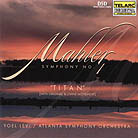December 2000
There have been as many critical opinions of performances of Mahler’s works as there have been reviews written, and most of the time, these opinions have differed as radically as the interpretations by the conductors involved. These days, however, it seems as if the interpretations are zeroing in on a single ideal -- no doubt due to the accessibility of an ever-growing number of recordings of these works, as well as the near universal consensus as to a "correct" way of playing them. I'm not saying that all conductors now interpret Mahler the same way -- they don’t -- but they are getting awfully close to an ideal of the "right way." Mahler revised the First Symphony many times, yet in spite of this, it never truly gained the approval of even the most open-minded late-nineteenth century audiences. Revision was his means of attempting to convert his listeners, as well as coping with his crippling self-doubt. He wrote the symphony between the years 1884 and 1888, revised it in 1893, and again around 1896. He seemed unsure of the Blumine movement, which he deleted and reinstated several times in performance before finally discarding it. It wasn’t until the early 1960s that this movement became available in a printed version of the score. The First Symphony is an odd one, ranging from high-Romantic bombast to delicate folk song quotes, including "Frère Jacques," to klezmer melodies, sorrowful elegies and even a quotation from Handel’s Messiah. The Blumine movement is lighter fare, but still recognizably Mahlerian -- and hearing the symphony in the order it was originally conceived is very, very interesting. My favorite recently released reading of this symphony remains the DG CD of Pierre Boulez conducting the CSO [289 459 610-2]. Say what you will about Boulez’s exacting style, it seems to fit Mahler just perfectly, not to mention that there are only a handful of orchestras that could realize his vision as successfully as Chicago. The Atlanta Symphony Orchestra is by no means as accomplished as the CSO, especially when it comes to Mahler. That said, they pull out all the stops this time. Yoel Levi brings them together with direction that verges on impeccable. Given my mild disappointment with his take on the other symphonies in this series, I had to make sure I had the correct CD in the transport upon first hearing it! The ASO not only sounds like a completely different orchestra on this CD, they play as though a different conductor is leading them. Among the recent outpouring of Mahler’s symphonies, the most engaging are those which marry a skillful conductor’s leadership, the orchestra's individual and ensemble playing and overall recording quality. This version of the First combines all three elements excellently. I also very much approve of the inclusion of the Blumine movement, and the fact that it appears on the CD as it was first performed -- as the second movement in this now fully restored five-movement work. The timings of all the movements seem remarkably similar to other recently recorded performances of this symphony (other than the Blumine, which is so rarely included), yet Levi injects a level of enthusiasm and devotion to the score that others don't bring to the table. Although it is a very emotional reading, Levi and the ASO never sound cloying. Most importantly, they exhibit a level of ensemble playing that is all too rare. This is quite a feat. While this is far from Mahler's most complex work, most conductors seem to misjudge the balance between emotion and momentum. This recording manages to give us the best of both worlds. Lest we forget that Telarc started out as a specialty audiophile label, this CD serves as a reminder -- if not a perfect example of how well a symphony orchestra can be recorded. I can hardly fault it, other than noting a very slight brassiness to its overall sound. The soundstage is wide and deep. Microphone placement is ideal and the disc's bass is thunderously deep. Whether the instruments are judged individually or as a whole, few recordings achieve a more natural sound. Yoel Levi and the Atlanta Symphony Orchestra have produced a near-perfect recording of a wonderful performance of a slightly imperfect symphony. GO BACK TO: |
 Mahler - Symphony No. 1 (Titan)
in D Major, with original Blumine movement
Mahler - Symphony No. 1 (Titan)
in D Major, with original Blumine movement![[Reviewed on CD]](../format/regcd.gif) This is
the fifth Mahler symphony Yoel Levi and the Atlanta Symphony Orchestra have recorded for
Telarc, having previously released CDs of his Fourth Symphony (coupled with Songs of a
Wayfarer) [CD-80499], as well as the Fifth [CD-80394], Sixth [CD-80444] and Seventh
[CD-80514]. The Second Symphony, planned for release next year, will be the last in the
series.
This is
the fifth Mahler symphony Yoel Levi and the Atlanta Symphony Orchestra have recorded for
Telarc, having previously released CDs of his Fourth Symphony (coupled with Songs of a
Wayfarer) [CD-80499], as well as the Fifth [CD-80394], Sixth [CD-80444] and Seventh
[CD-80514]. The Second Symphony, planned for release next year, will be the last in the
series.